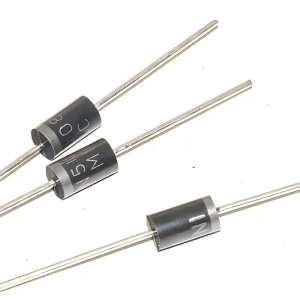Schottky Barrier Diode (SBD) is a diode that operates based on the Schottky barrier principle formed by the contact between metal and semiconductor. It has significant characteristics such as low forward voltage drop, high switching speed, and low reverse recovery time, and is widely used in electronic circuits such as high-frequency rectification, switching power supplies, and freewheeling diodes. The following analysis will be conducted from the aspects of definition, characteristics, application areas, and comparison of advantages and disadvantages:

1、 Definition and Basic Principles
The core structure of Schottky diodes is formed by direct contact between metals (such as aluminum, platinum, molybdenum, etc.) and N-type semiconductors (such as silicon). When metal comes into contact with semiconductor, a Schottky barrier is formed at the interface due to the difference in their work functions. This potential barrier determines the unidirectional conductivity of the diode:
Forward bias: When a metal is connected to the positive electrode and a semiconductor is connected to the negative electrode, the potential barrier decreases and electrons flow from the semiconductor to the metal, forming a forward current.
Reverse bias: When a metal is connected to the negative electrode and a semiconductor is connected to the positive electrode, the potential barrier rises and the current is effectively blocked.
Unlike traditional PN junction diodes, Schottky diodes have no minority carrier storage effect, resulting in faster switching speeds.
2、 Core feature analysis
Low forward voltage drop (VF)
Numerical range: typically 0.15V to 0.45V (much lower than 0.6V to 0.7V for silicon-based PN junction diodes).
Advantages: In high-frequency rectification or low voltage drop circuits, it can significantly reduce conduction losses and improve efficiency.
High switching speed
Reason: No reverse recovery time (TRR) due to the absence of minority carrier injection and recombination processes.
Data comparison: The switching speed can reach several hundred megahertz (MHz), far exceeding that of ordinary fast recovery diodes (usually tens of kilohertz).
Low Reverse Recovery Time (TRR)
Definition: The time required for the current to drop to zero when switching from forward conduction to reverse cutoff.
Meaning: In high-frequency switching power supplies, it can reduce switching losses and improve conversion efficiency.
Reverse leakage current (IR)
Characteristics: Usually higher than PN junction diodes (due to lower barrier height).
Impact: Under high temperature or high reverse voltage, attention should be paid to power consumption and thermal stability.
3、 Application Fields
High frequency rectification
Scenario: Switching Power Supply (SMPS), DC-DC Converter, Radio Frequency (RF) Circuit.
Advantages: Low VF reduces conduction loss, high switching speed adapts to high-frequency operation.
freewheeling diode
Scenario: Motor drive, relay protection, inductive load circuit.
Function: Provide a low impedance path during the release of inductive energy storage, suppressing voltage spikes.
Clamp and protection circuit
Scenario: ESD protection, voltage clamping.
Advantages: The fast response characteristic can effectively absorb transient voltages and protect sensitive components.
Solar cell bypass diode
Scenario: Photovoltaic modules.
Function: To prevent hot spot effects caused by local shadows and improve system reliability.
Material improvement
Silicon carbide (SiC) Schottky diode: with a voltage resistance of over 1200V, suitable for high-voltage and high-frequency scenarios (such as electric vehicle charging modules).
Gallium Nitride (GaN) Schottky diode: further reduces on resistance and increases switching frequency (up to GHz level).
Structural optimization
Trench Schottky diode: increases effective contact area through etching technology, reduces VF, and enhances voltage resistance.
Hybrid structure: Combining PN junction and Schottky barrier to balance VF and reverse withstand voltage (such as MPS diode).
Integrated application
Power module integration: Single chip integration with MOSFET, IGBT and other devices to simplify circuit design and improve power density.
Schottky diodes, with their core advantages of low VF and high switching speed, have become the preferred component for high-frequency and high-efficiency power conversion circuits. Its disadvantages, such as low reverse withstand voltage and high IR, can be gradually overcome through material innovation and structural optimization. With the maturity of wide bandgap semiconductor technologies such as silicon carbide and gallium nitride, the application areas of Schottky diodes will further expand to high-end fields such as new energy vehicles, 5G communications, and aerospace.
